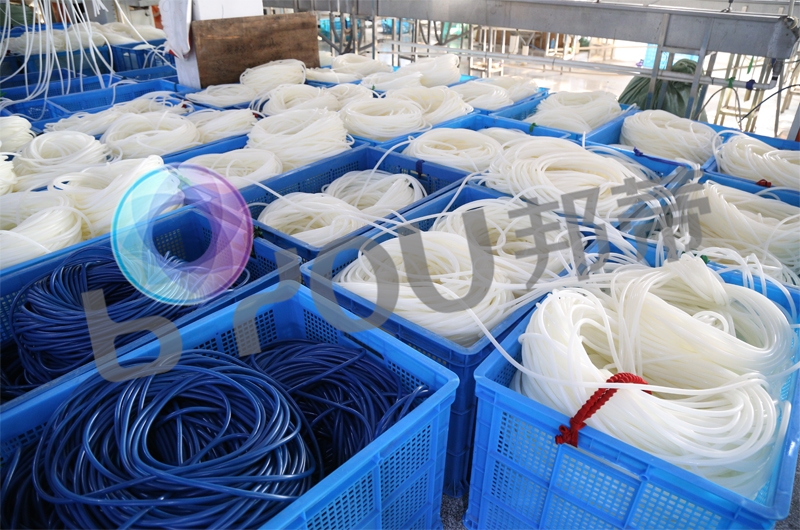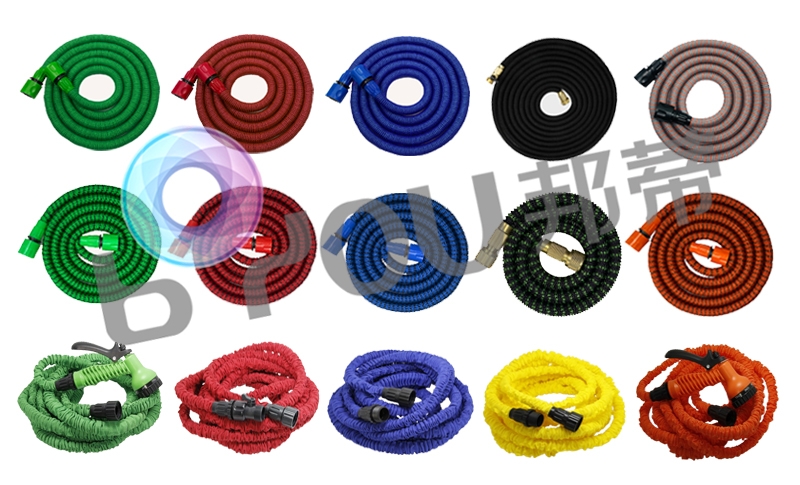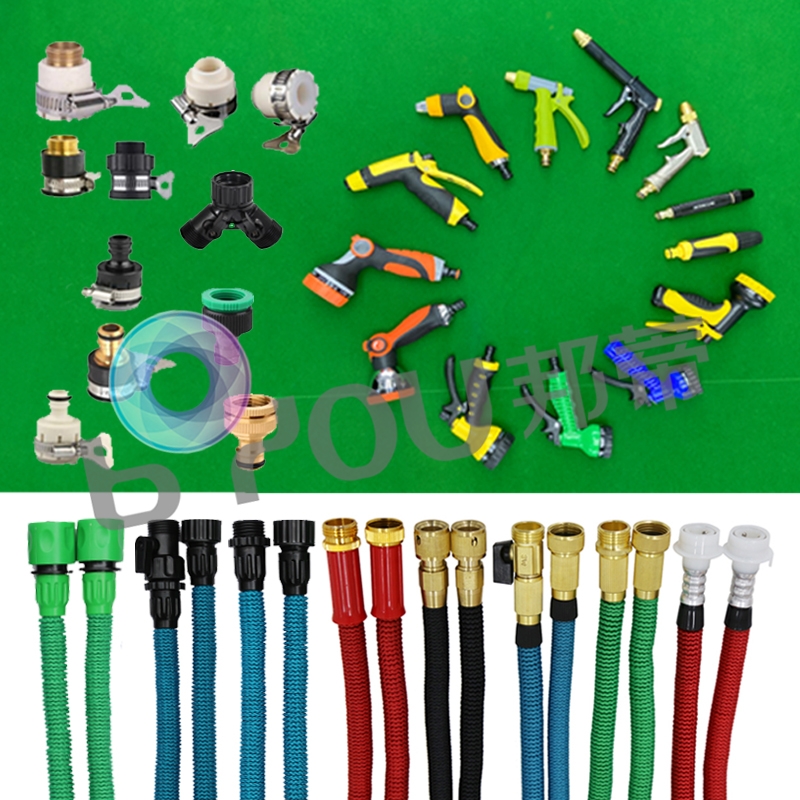Union Booster is a garden hose manufacturer from Wenzhou, China more than 10 years, which has another name called Pingyang Bangdi Electronic Technology Co., Ltd and the (hereinafter referred to as “Bangdi”). Bangdi partner is not only to focus on production, but also pays attention to the relationship between the expandable garden hose and environment. The article will introduce regular main materials of our expandable garden hose for your reference, which has combined with the shares of AI friends and Jane. Hope it can help you.

The regular material of our inner hose is TPE (thermoplastic elastomer), which is a widely recognized environmentally friendly material in the following obvious aspects:
The natural degradation time of traditional TPE is about 50-100years, but the eco-friendly TPE only takes about 3-12months. And for recycling, compare with the traditional rubbers needed desulfuration, TPE (including new material, production waste and waste products) can be recycled directly and repeatedly through melting processing due to its excellent thermoplasticity. But usually its recycled period is long, there is no need to replace frequently because of its good performances in wear resistance, aging resistance, high temperature resistance.The recyclability of TPE helps to reduce energy consumptions, emissions, the pressure of industrial waste disposal, resource waste and environmental pollution.
We purchase this material from the supplier with ROSH and REACH certifications. Therefore, our TPE does not contain heavy metals, halogens, phthalates and other harmful substances. In addition, TPE also can reduce the potential harm to the human body and the environment with its low VOCs (volatile organic compounds) characteristics.

Normally the material of our fabric cover is made of polyester with different deniers. There are the comparisons between normal polyester and RPET polyester for you to ponder.
Normal Polyester: About 67% of polyester production relies on petrochemicals, and each ton of products consumes 1.1 tons of crude oil, which will intensify fossil energy consumption as well as release volatile organic compounds (VOCs) and greenhouse gases (such as carbon dioxide) to cause pollution to air and water.
RPET Polyester: The waste plastic bottles (such as mineral water bottles and Coke bottles) are collected and converted into recycled fibers. According to statistics, about 67,000 plastic bottles are consumed into per ton of RPET yarn, which can save 0.0364 tons of oil, 6.2 tons of water, and reduce 4.2 tons of carbon dioxide emissions. Compare with normal polyester, it is effective to decrease the dependence on oil resources. There are about 32% reduction in energy consumption (Textile Exchange Data), about 76% reduction in water and electricity, about 71% reduction in carbon emissions (based on the Higg MSI research). Moreover, RPET polyester can prevent worse underground and ocean pollution from landfills and dumping large amounts of plastic garbage.
Research shows that polyester will begin to have an aging decomposition after about 100years. And it will take more than 450 years to degrade completely. Although the degradation time is shortened to 2-3 years by adding photosensitizers such as titanium dioxide, specific UV intensity is required and residual debris still poses a microplastic risk. And the time is about 3 months to decompose low-crystallinity PET with Aspergillus. The PETase/MHETase complex enzyme (Japanese research team) discovered in 2022 can decompose 90% of the PET film within 72 hours, but the efficiency is limited by the crystallinity (common polyester crystallinity >50%). Besides, some additives (e.g. flame retardants, dyes) will leak out at degradation to contaminate soils and groundwater.
Therefore, it is necessary for us to keep the consciousness of how to recycle polyester before there is an efficient and economical breakthrough of technologies in the polyester or exists suitable degradable alternative materials. Generally speaking, whether Normal Polyester or RPET Polyester, there are 2 kinds of common recycling methods - physical and chemical.
Physical Recycling: the recycling rate is about 60-70% because of the performance reduction, insufficient purity if raw materials and blending separation problem. And it will be used for lower-end products than before. Only 13% of the world's polyester is recycled physically (Textile Exchange 2023 Report). And the cost of recycling is 15-20% higher than that of virgin fiber, 50-150% higher than chemical recycling.
Chemical Recycling: The recycling rate is about 85% but higher energy consumption. Usually, the degradation products after chemical recycling are used for industry.

Our regular connectors and water guns are mainly made of PP, or ABS, or ABS overmolding, or aluminum alloy with brass plating, or pure brass.
As one of plastics, it will take hundreds of years to degrade under natural conditions, which will result in microplastic pollution. So it is advised to pay attention to recycle before solving the degradation problems or exploring suitable degradable alternative materials. There are also 2 kinds of common recycling methods - physical and chemical, which the cost of both is lower than PP raw material.
Physical Recycling: Lower cost than PP raw material for now. It will be reborn as some lower-end products than before because of the worse performance.
Chemical Recycling: More costly than PP raw material for now. PP degradation products (such as fatty acids, waxes) can be converted into biodiesel, surfactants or synthetic resins.
ABS is also a member of plastics but with higher energy consumption and cost than PP.
Physical Recycling: Lower cost than ABS raw material for now. And the performance of ABS will have a significant reduction after recycling for 3-5times. But PP can be recycled for 5-8times and has less reduction.
Chemical Recycling: More costly than ABS raw material for now. The recycling rate of ABS degradation products is about 60%(<70% not including by-products such as coke), but the pyrolysis oil production of PP is about 90%(>80%).
PS: ABS overmolding is similar with ABS, please refer to the article part of ABS
The main materials are aluminum and brass. This part will mention aluminum more and brass is in the next part “Brass”.
Most of aluminum is from bauxite, which is very difficult to be renewed. So, it will lead to resource shortage and ecological imbalances (e.g. damaging vegetation, soil structure and water resources) with the exhaustive exploitation. And during the aluminum production, especially electrolytic aluminum, it will cause "3 pollutions " to harm to the health of ecological environment and human being, namely air pollution, water pollution and solid waste pollution.
Air Pollution refers to release amounts of hazardous acid exhaust gas, alkaline exhaust gas and acid fog containing heavy metals without any treatment to pollute air.
Water Pollution refers to discharge the aluminum liquid wastewater contained heavy metal ions and organic matters directly without any treatment to pollute water.
Solid Waste Pollution refers to abandon lot of sludges and waste residues contained heavy metals and other harmful matters to soils and water without any treatment to cause pollution.
One more thing, the difference of thermal expansion coefficient between copper coating and aluminum substrate may accelerate material aging and indirectly increase waste generation.
It is worth mentioned that the energy consumption of recycled aluminum alloy is only 5% of that of primary aluminum, and it can be recycled more than 10 times. About 70% of aluminum in the automotive industry is recycled, effectively reducing the pressure on resource exploitation and environment pollution. For example, ADC12 recycled cast aluminum alloy accounts for 75% of recycled aluminum production and is used in components such as automotive engines. However, for aluminum alloy with brass plating, the plating is easy to be oxidized and peeled off after long-term use, which may affect the recycling efficiency. It is necessary to balance the dissolution rate of copper and the corrosion of aluminum matrix to optimize the reaction conditions.
Copper mining (opencast or underground working) leads to the destruction of vegetation, soil erosion, possible surface subsidence, possible landslides and possible damaged biodiversity.
Chemical agents (such as xanthate) discharged with wastewater will pollute water when proceed beneficiation.
The dust produced during ore crushing and transportation will affect the air quality.
And if tailings (waste contained heavy metals) are not properly solved, they will ooze to contaminate soil and groundwater.
Not only the exploitation, brass production will produce a lot of CO₂ (global copper smelting provides about 0.2% of carbon emissions), SO₂, NOₓ, PM, Cl₂, other hazardous gases, slag contained heavy metals, etc.
In terms of recycling, the energy consumption of recycled brass is only about 5-15% of that of primary copper, which relieve the environmental burden of mining, smelting, carbon emissions. And the separation technology of copper in mixed waste requires high requirements and fine sorting.
All in all, Bangdi as a manufacturer, has the responsibility to promote environmentally friendly production and green consumption habits. While waiting for technological innovation, what else we do is to improve the awareness of the environmental protection of material recycling and let more people focus on the inseparable relations between human and nature.